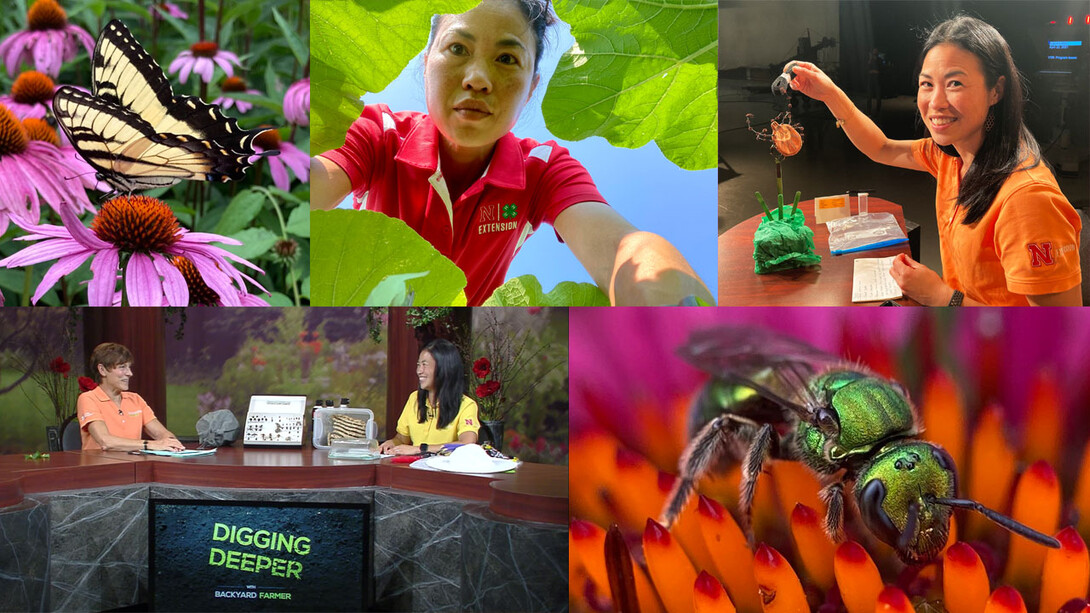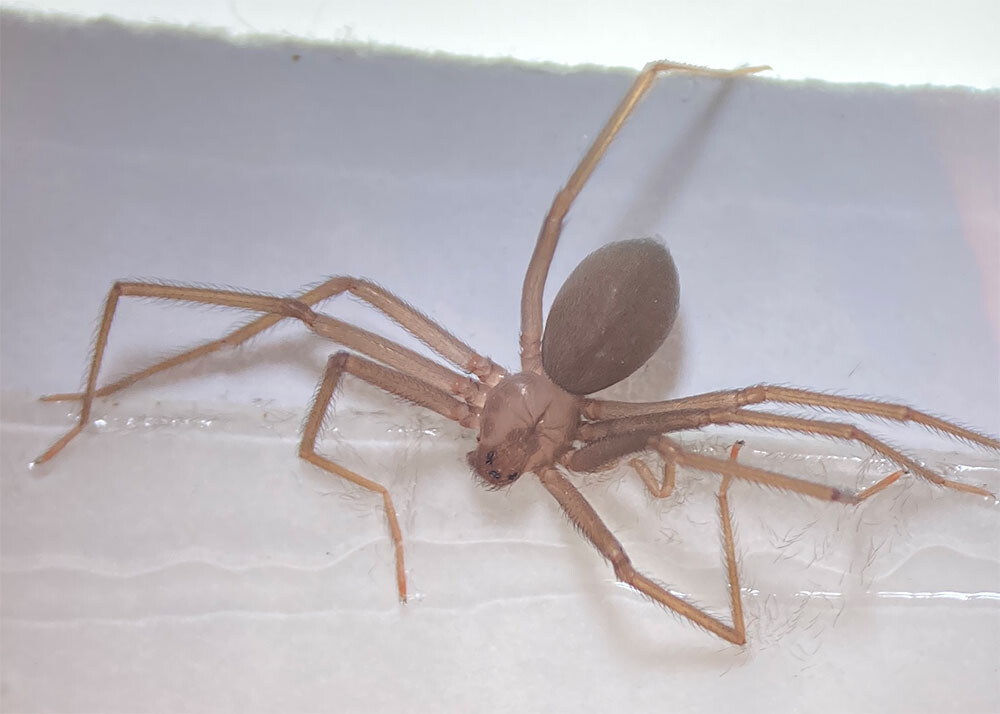
“The other day, someone came in with a picture of a cockroach that he got out of his ear.”
Jody Green keeps a running list of the 50 weirdest cases she’s encountered in her time as an urban entomologist with Nebraska Extension.
You might think that a wood cockroach flying into someone’s ear canal — an accidental detour on its way to the luminous temptation beaming near the man’s head — would be a shoo-in for that list. But like the winged, six-legged critter, you’d be off the mark.
In working for an extension office that covers Douglas and Sarpy counties, Green is among the go-to experts on insect- and arachnid-related questions for more than 750,000 Nebraskans. That means the extension educator winds up seeing “a lot of strange things.”
And because summer ranks as the busiest season for many insects, it’s by far the busiest for Green, too. It’s reached a point, she said, that she actively tries to say “no” at least twice a week just to avoid getting overrun.
“In summer, it’s nuts,” said Green, who works out of Omaha. “I just wait for the winter. It’s not like I’m not busy then, but I catch up, because all the bugs are dead or dormant or overwintering. They’re preparing to bug people in the spring. But during the summer, it’s just total chaos.”
About 80% of Green’s time is devoted to pests, real or perceived. Bed bugs, fleas and chiggers, among other biting insects. Wood destroyers like termites, carpenter ants and wood-boring beetles. Mosquitoes, ticks and other potential carriers of disease. Bees, wasps and similar stinging insects. The so-called fall invaders: ladybugs, boxelder bugs, cluster flies. The emerald ash borer, Japanese beetle and other invasive species.
And more. So many more.
“My specialty,” Green said, “is just being adaptable.”
A few weeks ago, a couple from Lincoln — technically outside her jurisdiction — made the hour-long drive up I-80 and walked into the extension office with a glue trap in hand. Stuck to the trap were brown recluse spiders, a huge number of which had taken up residence in the couple’s apartment.

Green went into therapist mode, listening to the couple’s questions and concerns, offering words of comfort and gentle explanation: People can have hundreds of them and not get bitten. These are the precautions to take. I understand why you don’t want to live there, and I think the landlord should be doing more.
Then she donned her detective hat, asking herself and the couple a series of questions: Why are the spiders there? Someone unwittingly imported them during a move-in, probably. What do they want? Food and mates, naturally. What insects might be around for the spiders to feed on? How many units are in the apartment? Have neighbors reported the brown recluses, too?
“For me, it’s really about being the Sherlock Holmes of the pests,” she said. “I want to know them. I want to think like them. I want to be able to keep them out, keep them away, but understand what they’re doing and why they’re doing it.”
She also wants, whenever possible, to avoid an overreliance on insecticides that can arise when homeowners or renters — sometimes contending with a phobia — take matters into their own hands or needlessly turn to a pest control company.
“The couple was like, ‘They’ve sprayed and sprayed and sprayed, and it’s not getting better,’” said Green, who was once an exterminator herself. “That’s not going to work. In this case, (the problem) can walk through walls. It’s really hard to treat for spiders with insecticides because of the nature of their biology. They can get across a room without contacting a treated surface.”
Fortunately, landlords are obligated to provide their tenants with a pest-free environment. So Green put the couple in touch with a Lancaster County health inspector she knew from a prior stint working in extension there.
“If I don’t know the answer, I say that I don’t know, but I help them find the resources they need,” she said. “If I were in jail, I’d be the person with all the cigarettes. I might not have it, but I can get it for you.”
As busy as she is with walk-ins and emails, Green also spends plenty of time getting out into the community and educating all sorts of people on all sorts of critters. She’s talked about bed bugs — if Green ever decided to focus on just one insect, they’d be it — with nurses and real estate professionals. In June, she partnered with 4-H for Nature Night Walk, a four-hour excursion through Schramm State Park that Green’s daughter canceled a sleepover just to attend.
“A lot of times,” Green said, “the parents are like, ‘This is really fun.’ I think that’s one thing about entomology, is that if you can get into it, it just makes you feel like a kid all the time.”
In August, she was invited to speak with the Bellevue and Papillion garden clubs, which hosted a potluck dinner alongside her talk on solitary bees. A couple of days later, Green received a bee-themed watercolor painted by one of the attendees.
“Just knowing that there are people that want to sit and eat dinner while I talk about bugs? It’s incredible,” she said.
Bugs being bugs, much of the education component can center on dispelling myths, including Green’s No. 1: that all insects are bad and out to hurt people. And much of that dispelling, she said, starts with listening and understanding why a given person believes as they do. Oftentimes, it stems from a bad experience or some misinformation absorbed at a formative age.
“You also have to watch what’s happening in the media, because people will see something on the news, or they’ll read something, or there’ll be a show or a movie,” she said. “And it puts it in their mind that they have, you know, ants in their brain or whatever. You have to be on top of it.”
It helps, she’s learned, to produce or appear in that media herself. This summer, Green co-hosted multiple episodes of Arthro-Pod, a long-running podcast created by a colleague. She wrote a blog entry for Entomology Today. Her Twitter account, @JodyBugsMeUNL, is a tribute to the wonders of arthropods: photos of a wolf spider towing her egg sac, time-lapse video of a monarch butterfly entering and emerging from its cocoon, video and photos of a steel-blue cricket-hunter wasp living up to its name.
Have you seen a swallowtail caterpillar’s osmeterium? Have you smelled a swallowtail caterpillar’s osmeterium? pic.twitter.com/fm2InnDlfB
— Jody Green (@JodyBugsMeUNL) August 3, 2021
She also just wrapped her latest season of appearances on the show “Backyard Farmer,” which runs from April through September on local PBS and NPR stations. Part of a rotating panel of experts, Green pops in for short segments or deep dives on the insects she knows best. On a recent episode, she had a monarch caterpillar eating from her hand. A swallowtail caterpillar, ready for its close-up, pooped on the same hand just as the camera zoomed in.
“I like to impress, and I like to bring live things,” she said. “I like to show things in their beauty, naturally, how people might see them in their garden.”
And when she’s feeling overwhelmed by the summer frenzy? Green said she finds refuge in the tranquility of her own garden and the company of some familiar friends.
“In the mornings, on the weekend, I get my coffee, and I walk around in the garden, and I look at the bugs,” she said. “I’m not looking at anyone else’s bugs; I’m looking at my own bugs. I’m just seeing what’s different, what’s new, what’s changed. I don’t know — I love it. It’s probably like when people go fishing or sit in a deer stand all day. It’s actually the most relaxed that I probably ever am.
“Whenever my family is like, ‘Where’s Mom?’ It’s always, ‘Oh, she’s just out there with her people again.’”







